Password is a widely used authentication tool, but businesses should implement additional security measures in this digital age categorized by many cyber threats. Multi-Factor authentication (MFA) is a type of authentication that adds multiple layers of security on top of credentials, such as usernames and passwords.
It follows Identity and Access Management policy and ensures that only authorized users can access accounts, applications, and corporate networks. The requirement of two or more verification factors helps minimize data theft cases. Here is how MFA provides different levels of security, including its different types and methods.
How Does MFA Work?
MFA asks the users about different types of information or “factors” to access an application or account. These factors rely on your possession (something you have), knowledge (something you know), or inherence (something you are). As MFA offers different levels of security, you can utilize adaptive MFA solutions to determine the context in which you want to deploy your factors.
For instance, if you have a hybrid workforce, you can deploy different security levels for your physical and remote workers. When a physical workforce wants to access an app, they will get a push notification that will ask them to deny or approve the access request.
On the contrary, the level of security should be enhanced when a remote worker wants to get access to your system. For instance, they should face a more secure multi-factor authentication for remote access, such as fingerprints or facial recognition.
Each additional factor in your MFA enhances the security of your system and ensures mobile security. This makes it an uphill battle for hackers to crack your security levels and access your sensitive information.
MFA Factors
The identification category used to access a system is known as “factors.” Here are three different factors involved in the authentication process and a brief overview of their level of effectiveness.
Knowledge-based Factors
It includes passwords, PINs, and security questions, such as asking about birthdays, nicknames, childhood favorite songs, etc. However, hackers using phishing or social engineering attacks easily steal this kind of information, so they offer the lowest level of security assurance.
Possession based factors
It includes mobile phones, credit cards, key fobs, and other physical tokens. Since the credentials are received or stored in these devices, possession-based authentication is more secure than knowledge-based authentication. However, there is a risk of devices being lost or stolen. They are susceptible to threats like a man-in-the-middle attack, so they offer a medium level of security assurance.
Inheritance-based Factors
Such factors offer a top level of security as they are unique to each user, such as facial features, fingerprints, voice characteristics, etc. users do not have to remember or store anything to get through these factors, which makes it the most secure MFA factor.
Different Types of MFA
Let’s talk about the working of different MFA solutions to understand their significance better.
Email Codes
The most popular kind of multifactor authentication is an email code. A unique code composed of numbers, letters, or a combination of both will be emailed to you for verification.
Though you do not need a working cell phone or any additional step, this option is not recommended, as cracking an email is a piece of cake for hackers.
Text or Call One-time Passwords
They are similar to email codes but are sent via different communication modes. When you enter a username and password, a PIN will be sent to you in the form of text or through a call.
You would need a cell phone for this factor, but no additional steps, such as downloading an app, would be needed. However, it would be time-restricted, so you have to retrieve it within the given time, otherwise, it would be rendered ineffective. Again, this is inadvisable as hackers can access your OTP through SIM swapping or SIM cloning.
Biometric Verification
This inheritance-based verification type can be anything from fingerprint to facial recognition. This option is also convenient as you do not have to wait for OPT. You would need a smartphone or computer to verify your presence.
It is a strong authentication method as you do not have to store any information, and it is unique to a user. Using it with other factors, such as knowledge-based factors, works best because it would leave some security gaps alone.
Physical Key
In case of very sensitive data, such as banking, insurance, investment, etc., you need a physical key to protect the information. Users are provided with some physical key that they insert to access the app or account.
It is one of the strongest options for granting access to your high-value users. However, providing every employee with a physical key would be practically hard. Businesses with budget limitations can’t solely rely on this authentication method.
Authenticator Apps
In this type of MFA, you need to download an app to get access. Big companies, such as Google, Microsoft, and Apple, have developed their authenticator apps for their users. It offers two authentication mechanisms.
Either you receive an access notification that you can accept or decline, or you would need to open the app and see the code, which will update every 30 seconds. This type of MFA is an incredible balance of security and convenience and is strongly recommended.
Conclusion
Adding multiple layers to your system will boost your business security and enhance your reputation among consumers. These multiple factors and authentication methods offer significant options to protect your system from hackers. Therefore, you should make an informed decision regarding the security of your business and customers.
Read Also: Taking a Good Look at Facial Recognition Technology



































































